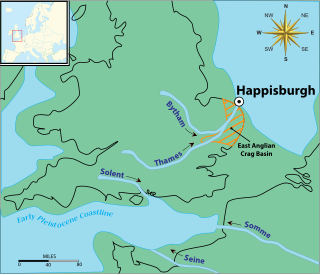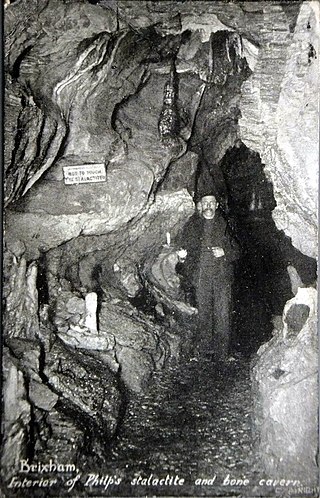
The Red "Lady" of Paviland is an Upper Paleolithic partial male skeleton dyed in red ochre and buried in Wales 33,000 BP. The bones were discovered in 1823 by William Buckland in an archaeological dig at Goat's Hole Cave which is a limestone cave between Port Eynon and Rhossili on the Gower Peninsula, near Swansea in south Wales. Buckland believed the skeleton was a Roman era female. Later, William Solace examined Goat's Cave Paviland in 1912. There, Solace found flint arrow heads and tools and correctly concluded that the skeleton was in fact a male hunter-gatherer or warrior during the last Ice Age. Over the last 100 years, more advanced dating procedures have shifted the age from the Mesolithic period to the Palaeolithic era of the last Ice Age.

Creswell Crags is an enclosed limestone gorge on the border between Derbyshire and Nottinghamshire, England, near the villages of Creswell and Whitwell. The cliffs in the ravine contain several caves that were occupied during the last ice age, between around 43,000 and 10,000 years ago. Its caves contain the northernmost cave art in Europe. The evidence of occupation found in the rich series of sediments that accumulated over many thousands of years is regarded as internationally unique in demonstrating how prehistoric people managed to live at the extreme northernmost limits of their territory during the Late Pleistocene period.

Several species of humans have intermittently occupied Great Britain for almost a million years. The earliest evidence of human occupation around 900,000 years ago is at Happisburgh on the Norfolk coast, with stone tools and footprints probably made by Homo antecessor. The oldest human fossils, around 500,000 years old, are of Homo heidelbergensis at Boxgrove in Sussex. Until this time Britain had been permanently connected to the Continent by a chalk ridge between South East England and northern France called the Weald-Artois Anticline, but during the Anglian Glaciation around 425,000 years ago a megaflood broke through the ridge, and Britain became an island when sea levels rose during the following Hoxnian interglacial.

Prehistoric archaeology is a subfield of archaeology, which deals specifically with artefacts, civilisations and other materials from societies that existed before any form of writing system or historical record. Often the field focuses on ages such as the Stone Age, Bronze Age and Iron Age, although it also encompasses periods such as the Neolithic. The study of prehistoric archaeology reflects the cultural concerns of modern society by showing interpretations of time between economic growth and political stability. It is related to other disciplines such as geology, biology, anthropology, historiography and palaeontology, although there are noticeable differences between the subjects they all broadly study to understand; the past, either organic or inorganic or the lives of humans. Prehistoric archaeology is also sometimes termed as anthropological archaeology because of its indirect traces with complex patterns.

John MacEnery was a Roman Catholic priest from Limerick, Ireland and early archaeologist who came to Devon as Chaplain to the Cary family at Torre Abbey in 1822. In 1825, 1826 and 1829, he investigated the prehistoric remains at Kent's Cavern in Devon, having been shown the cave by Thomas Northmore.

William Pengelly, FRS FGS was a British geologist and amateur archaeologist who was one of the first to contribute proof that the Biblical chronology of the earth calculated by Archbishop James Ussher was incorrect.
John James Wymer, was a British archaeologist and one of the leading experts on the Palaeolithic period.

Prehistoric Wales in terms of human settlements covers the period from about 230,000 years ago, the date attributed to the earliest human remains found in what is now Wales, to the year AD 48 when the Roman army began a military campaign against one of the Welsh tribes. Traditionally, historians have believed that successive waves of immigrants brought different cultures into the area, largely replacing the previous inhabitants, with the last wave of immigrants being the Celts. However, studies of population genetics now suggest that this may not be true, and that immigration was on a smaller scale.

Eartham Pit is an internationally important archaeological site north-east of Boxgrove in West Sussex with findings that date to the Lower Palaeolithic. The oldest human remains in Britain have been discovered on the site, fossils of Homo heidelbergensis dating to 500,000 years ago. Boxgrove is also one of the oldest sites in Europe with direct evidence of hunting and butchering by early humans. Only part of the site is protected through designation, one area being a 9.8-hectare (24-acre) geological Site of Special Scientific Interest, as well as a Geological Conservation Review site.

Swanscombe Skull Site or Swanscombe Heritage Park is a 3.9-hectare (9.6-acre) geological Site of Special Scientific Interest in Swanscombe, north-west Kent, England. It contains two Geological Conservation Review sites and a National Nature Reserve. The park lies in a former gravel quarry, Barnfield Pit.
Events from the prehistory of Britain.

The Bontnewydd palaeolithic site, also known in its unmutated form as Pontnewydd, is an archaeological site near St Asaph, Denbighshire, Wales. It is one of only three sites in Britain to have produced fossils of ancient species of humans and the only one with fossils of a classic Neanderthal. It is located a few yards east of the River Elwy, near the hamlet of Bontnewydd, near Cefn Meiriadog, Denbighshire.

Thomas Northmore FSA (1766–1851) was an English writer, inventor and geologist.
The discovery of human antiquity was a major achievement of science in the middle of the 19th century, and the foundation of scientific paleoanthropology. The antiquity of man, human antiquity, or in simpler language the age of the human race, are names given to the series of scientific debates it involved, which with modifications continue in the 21st century. These debates have clarified and given scientific evidence, from a number of disciplines, towards solving the basic question of dating the first human being.

The Happisburgh footprints were a set of fossilized hominid footprints that date to the end of the Early Pleistocene, around 950-850,000 years ago. They were discovered in May 2013 in a newly uncovered sediment layer of the Cromer Forest Bed on a beach at Happisburgh in Norfolk, England, and carefully photographed in 3D before being destroyed by the tide shortly afterwards.
The Kents Cavern 4 maxilla is a human fossil consisting of a right canine, third premolar, and first molar as well as the bone holding them together including a small piece of palate. The fossil was found in 1927 at Kents Cavern, a limestone cave in Torquay, Devon, England. The maxilla was uncovered at a depth of 10 feet 6 inches (3.20 m) and was located directly beneath a key ‘granular stalagmite’ at the site, which was used as a datum during excavations undertaken between 1926 and 1941 by the Torquay Natural History Society. The discovery of the KC4 maxilla was important because it became the earliest direct dated anatomically modern human (AMH) fossil yet discovered from a northwestern European site. Moreover the date obtained via a Bayesian statistical-modelling method provides evidence for the coexistence of anatomically modern humans and Neanderthals.

Ash Hole Cavern is a limestone cave system in Brixham, Devon, England. There is evidence of human habitation since Neolithic times, and archaeological excavations have been conducted, with several artefacts found. It has been a scheduled monument since 1966.
Paul Barry Pettitt, FSA is a British archaeologist and academic. He specialises in the Palaeolithic era, with particular focus on claims of art and burial practices of the Neanderthals and Pleistocene Homo sapiens, and methods of determining the age of artefacts from this time. Since 2013, he has been Professor of Archaeology at Durham University. He previously taught at Keble College, Oxford and the University of Sheffield.

Windmill Hill Cavern is a limestone cave system in the town of Brixham, Devon. It was discovered in 1858 and later excavated by a team led by the geologist William Pengelly, who found proof that humans co-existed with extinct British fauna.
Roger Michael Jacobi was a British archaeologist specialising in Palaeolithic and Mesolithic Britain. Known for his encyclopaedic knowledge of British prehistory, Jacobi authored several key synthetic volumes and worked to catalogue, sequence and reanalyse collections from across Britain and northwestern Europe. Sections of his extensive personal archive were posthumously published as the Palaeolithic and Mesolithic Artefact (PaMELA) database. He studied archaeology at Jesus College, Cambridge, and held positions at Lancaster University, the University of Nottingham, and the British Museum.

















